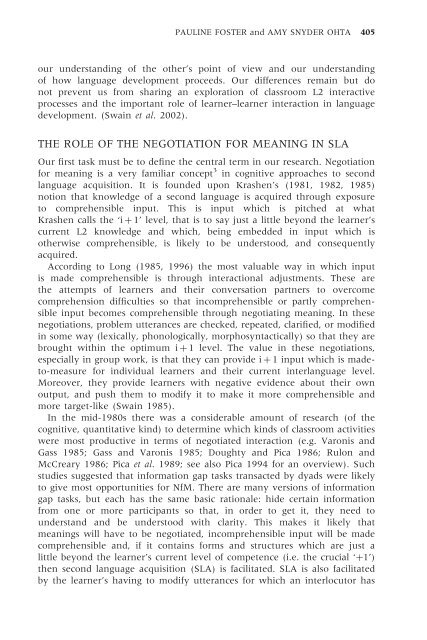Negotiation for Meaning and Peer Assistance in Second Language ...
Negotiation for Meaning and Peer Assistance in Second Language ...
Negotiation for Meaning and Peer Assistance in Second Language ...
Create successful ePaper yourself
Turn your PDF publications into a flip-book with our unique Google optimized e-Paper software.
PAULINE FOSTER <strong>and</strong> AMY SNYDER OHTA 405<br />
our underst<strong>and</strong><strong>in</strong>g of the other’s po<strong>in</strong>t of view <strong>and</strong> our underst<strong>and</strong><strong>in</strong>g<br />
of how language development proceeds. Our differences rema<strong>in</strong> but do<br />
not prevent us from shar<strong>in</strong>g an exploration of classroom L2 <strong>in</strong>teractive<br />
processes <strong>and</strong> the important role of learner–learner <strong>in</strong>teraction <strong>in</strong> language<br />
development. (Swa<strong>in</strong> et al. 2002).<br />
THE ROLE OF THE NEGOTIATION FOR MEANING IN SLA<br />
Our first task must be to def<strong>in</strong>e the central term <strong>in</strong> our research. <strong>Negotiation</strong><br />
<strong>for</strong> mean<strong>in</strong>g is a very familiar concept 3 <strong>in</strong> cognitive approaches to second<br />
language acquisition. It is founded upon Krashen’s (1981, 1982, 1985)<br />
notion that knowledge of a second language is acquired through exposure<br />
to comprehensible <strong>in</strong>put. This is <strong>in</strong>put which is pitched at what<br />
Krashen calls the ‘i þ 1’ level, that is to say just a little beyond the learner’s<br />
current L2 knowledge <strong>and</strong> which, be<strong>in</strong>g embedded <strong>in</strong> <strong>in</strong>put which is<br />
otherwise comprehensible, is likely to be understood, <strong>and</strong> consequently<br />
acquired.<br />
Accord<strong>in</strong>g to Long (1985, 1996) the most valuable way <strong>in</strong> which <strong>in</strong>put<br />
is made comprehensible is through <strong>in</strong>teractional adjustments. These are<br />
the attempts of learners <strong>and</strong> their conversation partners to overcome<br />
comprehension difficulties so that <strong>in</strong>comprehensible or partly comprehensible<br />
<strong>in</strong>put becomes comprehensible through negotiat<strong>in</strong>g mean<strong>in</strong>g. In these<br />
negotiations, problem utterances are checked, repeated, clarified, or modified<br />
<strong>in</strong> some way (lexically, phonologically, morphosyntactically) so that they are<br />
brought with<strong>in</strong> the optimum i þ 1 level. The value <strong>in</strong> these negotiations,<br />
especially <strong>in</strong> group work, is that they can provide i þ 1 <strong>in</strong>put which is madeto-measure<br />
<strong>for</strong> <strong>in</strong>dividual learners <strong>and</strong> their current <strong>in</strong>terlanguage level.<br />
Moreover, they provide learners with negative evidence about their own<br />
output, <strong>and</strong> push them to modify it to make it more comprehensible <strong>and</strong><br />
more target-like (Swa<strong>in</strong> 1985).<br />
In the mid-1980s there was a considerable amount of research (of the<br />
cognitive, quantitative k<strong>in</strong>d) to determ<strong>in</strong>e which k<strong>in</strong>ds of classroom activities<br />
were most productive <strong>in</strong> terms of negotiated <strong>in</strong>teraction (e.g. Varonis <strong>and</strong><br />
Gass 1985; Gass <strong>and</strong> Varonis 1985; Doughty <strong>and</strong> Pica 1986; Rulon <strong>and</strong><br />
McCreary 1986; Pica et al. 1989; see also Pica 1994 <strong>for</strong> an overview). Such<br />
studies suggested that <strong>in</strong><strong>for</strong>mation gap tasks transacted by dyads were likely<br />
to give most opportunities <strong>for</strong> NfM. There are many versions of <strong>in</strong><strong>for</strong>mation<br />
gap tasks, but each has the same basic rationale: hide certa<strong>in</strong> <strong>in</strong><strong>for</strong>mation<br />
from one or more participants so that, <strong>in</strong> order to get it, they need to<br />
underst<strong>and</strong> <strong>and</strong> be understood with clarity. This makes it likely that<br />
mean<strong>in</strong>gs will have to be negotiated, <strong>in</strong>comprehensible <strong>in</strong>put will be made<br />
comprehensible <strong>and</strong>, if it conta<strong>in</strong>s <strong>for</strong>ms <strong>and</strong> structures which are just a<br />
little beyond the learner’s current level of competence (i.e. the crucial ‘þ1’)<br />
then second language acquisition (SLA) is facilitated. SLA is also facilitated<br />
by the learner’s hav<strong>in</strong>g to modify utterances <strong>for</strong> which an <strong>in</strong>terlocutor has














